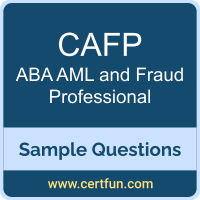 Getting knowledge of the ABA CAFP exam structure and question format is vital in preparing for the ABA AML and Fraud Professional certification exam. Our ABA AML and Fraud Professional sample questions offer you information regarding the question types and level of difficulty you will face in the real exam. The benefit of using these ABA CAFP sample questions is that you will get to check your preparation level or enhance your knowledge by learning the unknown questions. You will also get a clear idea of the exam environment and exam pattern you will face in the actual exam with the ABA AML and Fraud Professional Sample Practice Test. Therefore, solve the ABA AML and Fraud Professional sample questions to stay one step forward in grabbing the ABA Certified AML and Fraud Professional (CAFP) credential.
Getting knowledge of the ABA CAFP exam structure and question format is vital in preparing for the ABA AML and Fraud Professional certification exam. Our ABA AML and Fraud Professional sample questions offer you information regarding the question types and level of difficulty you will face in the real exam. The benefit of using these ABA CAFP sample questions is that you will get to check your preparation level or enhance your knowledge by learning the unknown questions. You will also get a clear idea of the exam environment and exam pattern you will face in the actual exam with the ABA AML and Fraud Professional Sample Practice Test. Therefore, solve the ABA AML and Fraud Professional sample questions to stay one step forward in grabbing the ABA Certified AML and Fraud Professional (CAFP) credential.
These ABA CAFP sample questions are simple and basic questions similar to the actual ABA AML and Fraud Professional questions. If you want to evaluate your preparation level, we suggest taking our ABA AML and Fraud Professional Premium Practice Test. You might face difficulties while solving the real-exam-like questions. But, you can work hard and build your confidence on the syllabus topics through unlimited practice attempts.
ABA CAFP Sample Questions:
Answers:
|
Question: 01 Answer: b |
Question: 02 Answer: d |
Question: 03 Answer: c |
Question: 04 Answer: b |
Question: 05 Answer: a |
|
Question: 06 Answer: c |
Question: 07 Answer: a |
Question: 08 Answer: d |
Question: 09 Answer: c |
Question: 10 Answer: d |
Note: For any error in ABA AML and Fraud Professional (CAFP) certification exam sample questions, please update us by writing an email on feedback@certfun.com.
